I’ve been a fan of taxidermy for as long as I can remember. Because who couldn’t be bewitched by Walter Potter’s kitten wedding or Polly Morgan’s quail receiver?
With zeal, relish, and now I sheepishly admit, unfounded bravado, I accepted an invitation to try my own hand at it at Margot Magpie’s near perennially sold-out Anthropomorphic Mouse Taxidermy class.
When I told people my plans, most were aghast. “But you’re a vegetarian!” they exclaimed. Well, I reasoned, I’m not planning to eat them.

Margot Magpie's snoozing mouse brooch
“Eurgh!” said my mother, before hastily adding: “That sounds nice”.
As my dad quite logically pointed out: “A mouse? But they’re so little and fiddly, can’t you practice on a rhino first?” (No dad, I can’t).
The mice in question are ethically sourced from frozen pet food suppliers and hence have not been killed for the purpose of taxidermy. What’s more, if they weren’t sold they would be thrown away.
My four-hour class was held at Blacks in Soho, where Margot received us looking like she’s stepped off the set of Alice In Wonderland wearing a crow wing fascinator and a beautiful brooch featuring a tiny snoozing mouse.
Our mice were laid out at the tables, prone and ready for us. According to consensus, my mouse was the prettiest. Piece of cake, I thought. This is going to be great.
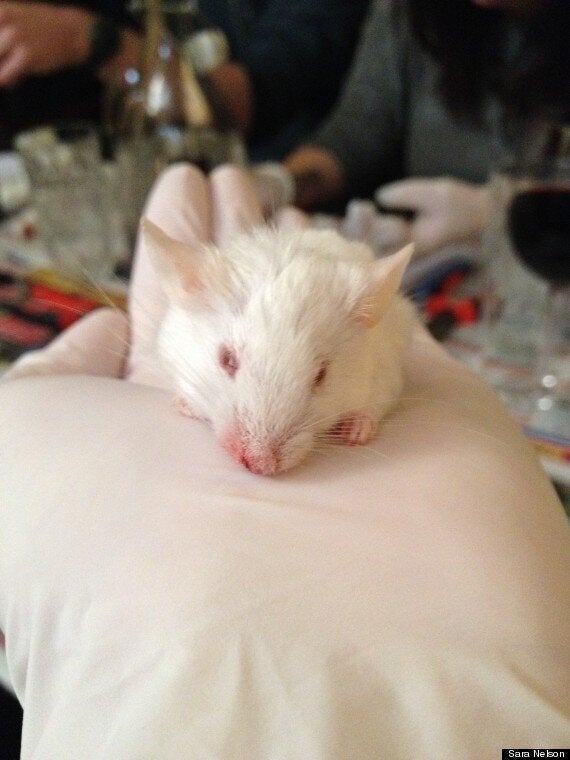
My mouse was definitely the prettiest, even if I do say so myself
A box of miniature props was handed around and we pawed excitedly through tiny vacuum cleaners, skipping ropes and dining sets, picturing our finished rodents engaged in all manner of activities.
As it becomes ever popular among cool urbanites, modern taxidermy has earned itself something of a “hipster” reputation , albeit an undeserved one, Margot says.
“These classes break boundaries and give people hands-on experience with something dead, which they then learn about the anatomy and preservation of - it's a very wide range of people coming to these classes and not a bunch of angsty teens dressed in black. Nor is it solely reserved for the super cool hipster set of East London.”
Margot also dismisses the other suggestion taxidermy is a hobby preferred by Goths or those who have “something of the night about them”.

Mouse aloft, Margot shows us how it's done
“The classes are a macabre endeavour. I don't mind them being couched in that - what I do mind is people making that an excuse for disliking it or generalising it as a hobby for Goths.
“Taking something dead and making it look alive again is something humans have been doing for centuries. I think one of the main reasons people like to try taxidermy is because we don’t have exposure to death in everyday society like the Victorians or in other cultures,” she explains.
Margot, who is a member of the UK Guild of Taxidermists, adds: “Dressing dead mice up as if they were little humans reading the paper, or going fishing is just a way of facing the inevitable death of everything around us a bit easier to deal with.”
What’s more, Margot (who did not eat meat herself for 13 years) neatly addressed the vegetarian "conundrum" in her blog last year.
The former vet nurse explains her vegetarianism came from a love of animals and a hatred for the way the meat industry works.
She continued: “Many vegetarians learning taxidermy will make it very clear that the animals they work on must not be killed for the purpose of taxidermy (as I do). Many see it as an opportunity, however, to preserve nature or make something creative out of what is normally wasted.”
Despite this, and for all of my enthusiasm and grand designs for my mouse, I must confess I fell at the first hurdle.
I get as far as putting him on his back, arranging him in a star-jump shape and cutting through his sternum with my scalpel when the smell hits me and I am out of the game.
I turn white. I’m gagging and there’s nothing for it but to turn to the bar and gulp down wine until normal equilibrium is restored.
So while I had to sit most of this one out, I can tell you all about it and what my other classmates made of it.
Couple Jessica O’Neill and Matt Knell booked their course as an early Valentine’s treat (sadly for them, Margot’s class on February 15 was sold out).
“It’s no different to a chicken thigh”, says a cheerful, scalpel-wielding Jess, who incidentally bought Matt a stuffed raven for Christmas.
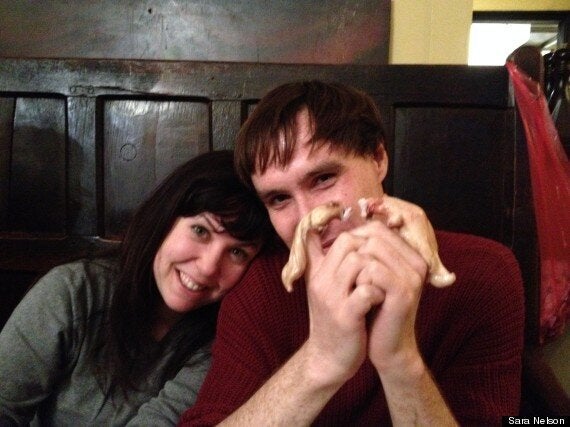
Jessica O'Neill and Matt Knell share a romantic moment over their mouse pelts
She added: “When Matt told me about the taxidermy class I knew it was something we absolutely had to do, and oddly, I am finding it very romantic!”
Matt concurred: “I think we’d both get bored without exploring off the beaten track every now and again. And yes, I’d call being cosily huddled up in a dimly lit Soho basement bar supping on half decent wine and in conversation together for hours romantic.
SEE ALSO:
“I must admit, even as an ex-vegetarian of 15 years, I didn’t find this too horrific – as Jess said, it wasn’t too dissimilar to stuffing a chicken. Except with fur and a face and wee little cute hands.”
Eva Tsang, who like me is also a fan of Polly Morgan, told me: “I just could not believe dead animals could be turned into such beautiful objects.”
Despite describing herself as a squeamish person, Eva seemed entirely comfortable with the scalpel.
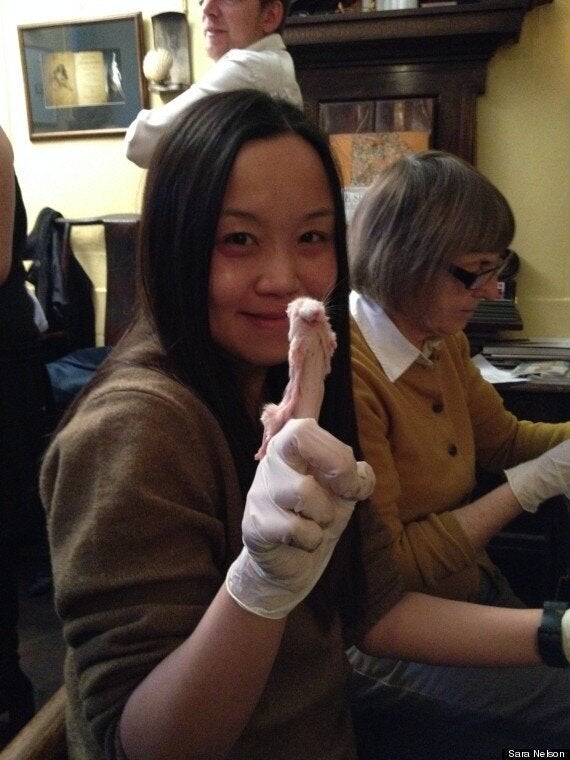
Eva Tsang was unfazed by the gore - and the smell
“I think it could be because the animal was already dead, and I knew there is nothing I could do to harm it in any way, except to stuff it very badly might upset it's poor soul!” she added.
Once the scalpels are laid down it’s time to remove the innards.
“Make a mouse ring”, says Margot, expertly twirling the pelt of an “emptied” rodent.
These are the inescapably macabre moments. Once the innards have been removed all that’s left are a series of empty “mouse capes”, which results in a series of performances reminiscent of Fingermouse.
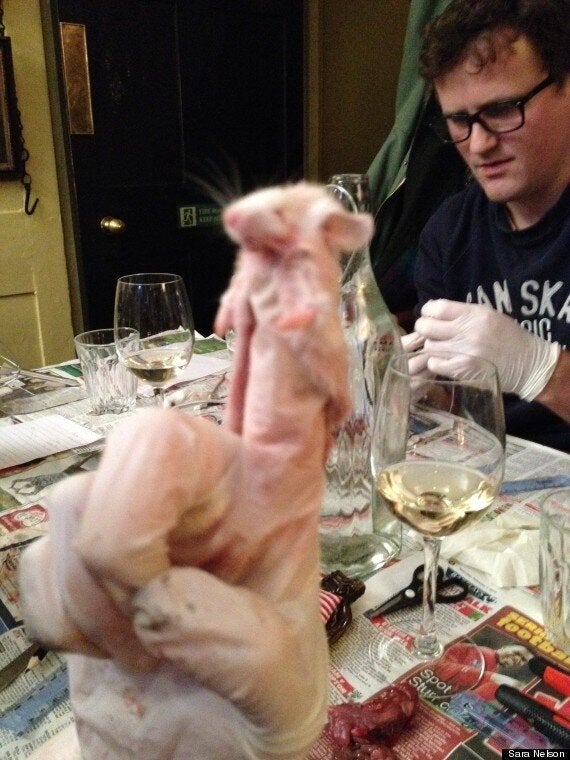
Fingermouse's cousin makes a mercifully blurred appearance
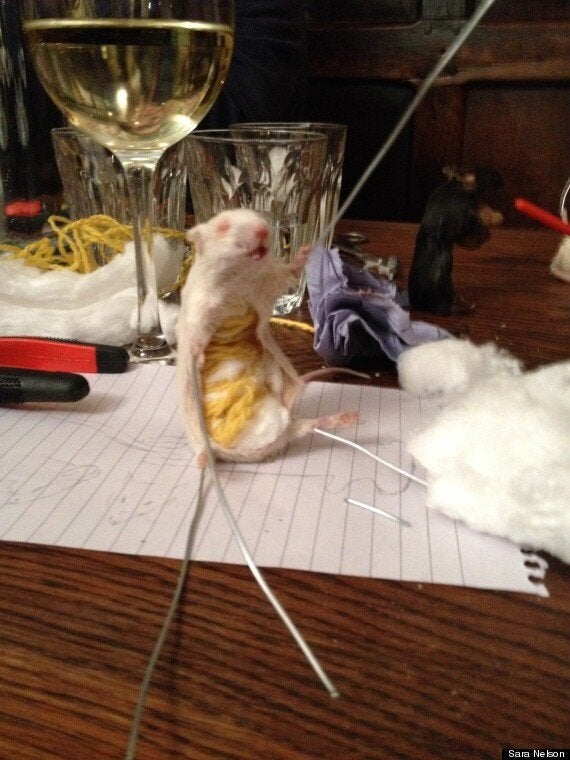
Once the mice are cleaned and stuffed, wires are inserted to shape their limbs
The mice are duly washed, blow-dried and stuffed with cotton wool, which is when they begin to resemble their previous forms. Wires are inserted to shape the limbs and eyes are glued on.
There is a huge tenderness between each person and their mouse. For all of the gore, is a gentle art and while Margot warned us not to expect perfect results, there is real care and dedication exhibited for each and every work.
Indeed, says Margot: “I think like any pet or any work of art they become endearing and prideful extensions of ourselves.”
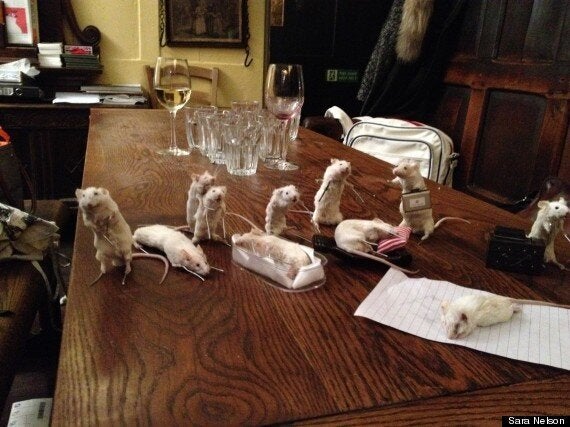
The final line-up: Not bad chaps, not bad at all
The wires must remain poking out of the body for a day or two while the mouse dries so they don’t look entirely finished in their final line-up.
From my position on the sidelines, taxidermy is unusual, fascinating and deeply personal. And it’s harder than you think.
I’ve definitely revised my delusions of grandeur and I’m sure that had I been able to participate, my efforts would have been more along the lines of the unofficial “terrible taxidermy” series which float around the internet.
Matt’s mouse, I am sure he doesn’t mind me saying, probably does fit into this category. During the insertion of wires, we unanimously decide that his somewhat startled-looking, overstuffed mouse looks like John Carpenter’s The Thing.
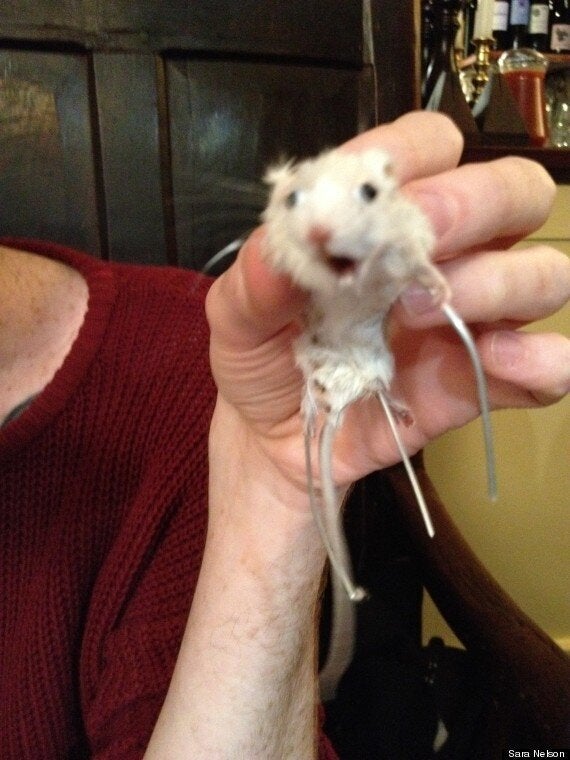
We called it 'the John Carpenter' mouse
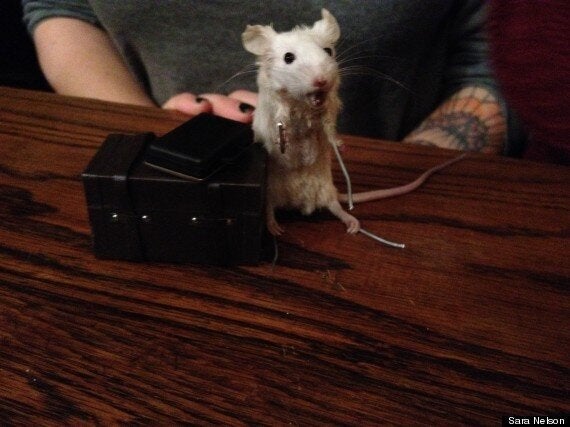
While Jess's mouse gathered his luggage and made a more dignified exit
Eva’s is particularly handsome and Jess is already planning to start taxidermy at home. (Meanwhile Matt is talking about putting his “Frankenstein snake mouse” in the bin... you can’t win ‘em all, Margot)
Margot runs anthropomorphic taxidermy classes in London and occasionally elsewhere in Britain. Standard tickets are £60 and she also offers private courses.